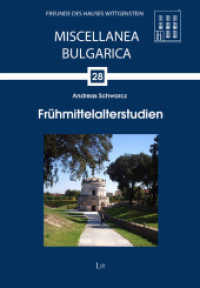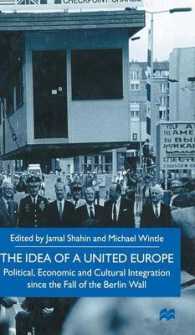- ホーム
- > 洋書
- > 英文書
- > Literary Criticism
Full Description
Geographies of Relation offers a new lens for examining diaspora and borderlands texts and performances that considers the inseparability of race, ethnicity, and gender in imagining and enacting social change. Theresa Delgadillo crosses interdisciplinary and canonical borders to investigate the interrelationships of African-descended Latinx and mestizx peoples through an analysis of Latin American, Latinx, and African American literature, film, and performance.
Not only does Delgadillo offer a rare extended analysis of Black Latinidades in Chicanx literature and theory, but she also considers over a century's worth of literary, cinematic, and performative texts to support her argument about the significance of these cultural sites and overlaps. Chapters illuminate the significance of Toña La Negra in the Golden Age of Mexican cinema, reconsider feminist theorist Gloria Anzaldúa's work in revising exclusionary Latin American ideologies of mestizaje, delve into the racial and gender frameworks Sandra Cisneros attempts to rewrite, unpack encounters between African Americans and Black Puerto Ricans in texts by James Baldwin and Marta Moreno Vega, explore the African diaspora in colonial and contemporary Peru through Daniel Alarcón's literature and the documentary Soy Andina, and revisit the centrality of Black power in ending colonialism in Cuban narratives. Geographies of Relation demonstrates the long histories of networks and exchanges across the Americas as well as the interrelationships among Indigenous, Black, African American, mestizx, Chicanx, and Latinx peoples. It offers a compelling argument that geographies of relation are as significant as national frameworks in structuring cultural formation and change in this hemisphere.
Contents
Table of Contents
List of Illustrations
Acknowledgments
Introduction: Geographies of Relation
Chapter 1: Toña La Negra's Performance of Mexicanidad and Black Diaspora Consciousness
Chapter 2: Cultivating Consciousness of Race and Gender in the Chicanx and Mexican Borderlands
Chapter 3: An East Side, Downtown, and Greenwich Village Story: Puerto Rican and African American Diaspora Discoveries in New York City
Chapter 4: Centering Peru's Black Diaspora While Querying Dominant Cultures in the U.S.-Peru Borderlands
Chapter 5: Black Cuban Life in Movements and Fictions of Social Change
Conclusion
"The Interdependency of Different Strengths"
Bibliography
Index








